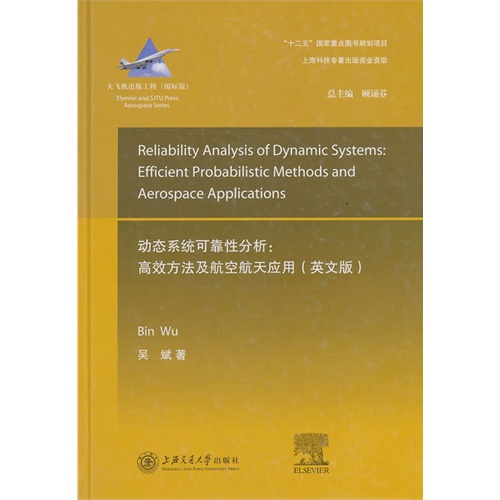
包邮动态系统可靠性分析:高效方法及航空航天应用-(英文版)

- ISBN:9787313101709
- 装帧:一般胶版纸
- 册数:暂无
- 重量:暂无
- 开本:16开
- 页数:202
- 出版时间:2013-11-01
- 条形码:9787313101709 ; 978-7-313-10170-9
本书特色
《动态系统可靠性分析--高效方法及航空航天 应用(英文版)(精)/大飞机出版工程》编著者吴 斌。 《动态系统可靠性分析--高效方法及航空航天 应用(英文版)(精)/大飞机出版工程》针对动态 系统的可靠性分析,阐述了一种新的优化技术,即针 对低频率谐 振动力载荷下的工程产品结构可靠性问题,使用综合 的快速概率方法,也即“扰动 算法+蒙特卡洛方法”。在针对两个航空航天实际工 程案例的应用中发现,运用此 方法能快速准确地解决失效面高非线性、大量计算强 度和动态系统高复杂度等原 有概率方法的应用困难。本书的出版填补了国际上对 高效快速概率方法的研究空 白。 本书可供从事民用飞机结构可靠性安全性工程设 计分析、试验、管理的技术人 员和相关专业的研究生使用。
内容简介
《动态系统可靠性分析--高效方法及航空航天应用(英文版)(精)/大飞机出版工程》编著者吴斌。 本书根据作者在剑桥大学工程系可靠性专业多年研究成果和近几年来在中国商飞公司民机研制的实践经验编撰而成,主要阐述了一种处理工程结构可靠性和安全性问题的综合优化方法,即针对低频率谐振动力载荷下的复杂的工程产品结构可靠性问题,使用综合的快速概率方法。此方法旨在克服概率方法应用的困难,比如失效面的高非线性问题、大量的计算强度和动态系统的高复杂度等。这是在总结现有的各种分析方法的基础上,提出的一种*新的基于非确定因素的概率分析方法,体现国际*新发展。
目录
dedication
preface
acknowledgments
nomenclature
list of figures
list of tables
1.introduction
1.1 structural reliability analysis
1.2 non-deterministic reliability analysis methods
1.2.1 monte carlo simulation (mcs) method
1.2.2 form (first-order reliability method)
1.2.3 interval analysis
1.2.4 fuzzy analysis
1.2.5 response surface method (rsm)
1.2.6 summary
1.3 uncertainty analysis of dynamic systems
1.3.1 background
1.3.2 literature review of analytical approaches to dynamic systems
1.3.3 summary
1.4 scope of the present work
1.5 overview of the book
2.technical background
2.1 definition of structural reliability
2.2 technical basis of the monte carlo simulation method
2.3 theory of the first-order reliability method (form)
2.4 response surface method
2.4.1 response surface models and fitting techniques
2.4.2 sampling design methods
2.5 problems of applying form and rsm methods to dynamic systems
2.5.1 problematic failure surfaces for form applications
2.5.2 inaccuracy of rsm in predicting the dynamic response
2.6 optimization solution through modal analysis
3.theoretical fundamentals of the perturbation approach
3.1 definition of the new parameters and safety margin
3.2 derivation of the two moments of the new parameters
3.2.1 derivation of the covariance matrix of the modal parameter w2
3.2.2 derivation of the covariance matrix of the defined parameter dr
3.2.3 derivation of the covariance matrix of the modal parameter [□]
3.2.4 derivation of the covariance matrix of the defined parameter rjk,r
3.2.5 derivation of the covariance matrix of the combined parameter t
3.2.6 derivation of the mean values of the defined parameters dr and rik,r
3.3 application procedure of the new approach
3.4 discussion
3.5 summary
4.application to a 2d system
4.1 finite element model of a 2d dynamic system
4.2 applying the combined approach: preliminary analysis
4.2.1 response analysis
4.2.2 safety margin contour
4.3 perturbation approach + form method
4.3.1 evaluating the probability of failure and in-depth analysis
4.3.2 solution 1: second-order approximation of d2
4.3.3 solution 2: new variable e2 to replace d2
4.3.4 solution 3: variable □ to replace e2
4.4 solution 4: monte carlo simulation replacing form
4.4.1 perturbation + monte carlo simulation on r2 and w□
4.4.2 reliability analysis of the updated combined approach
4.5 summary
5.application to a 3d helicopter model
5.1 background of helicopter vibration'control
5.2 a 3d helicopter ee model
5.2.1 system details
5.2.2 dynamic characteristics of the model
5.3 response analysis
5.4 reliability analysis of the combined approach
5.4.1 probability vs. excitation frequencies
5.4.2 probability vs. maximum displacement and variation coefficient
5.5 efficiency analysis
5.6 summary
6.complete combined approach
6.1 response surface techniques in obtaining ck
6.1.1 direct rs model fitting of the stiffness matrix k
6.1.2 alternative fitting approach
6.1.3 analytical approach to obtain the covariance matrix of k
6.1.4 complete combined approach
6.2 complete application to 2d frame model
6.2.1 type i rs model fitting with koshal design
6.2.2 complete combined approach
6.3 complete application to 3d helicopter model
6.4 summary
7.conclusions and future work
7.1 achievements and conclusions
7.2 future work
7.2.1 application of an enhanced form method
7.2.2 further simplification of perturbation/analytical algorithms
7.2.3 development for non-probabilistic methods
appendix ⅰ:transforming random variables from correlated to uncorrelated
appendix ⅱ:analytical solution of hl safety index
appendix ⅲ:modal analysis of dynamic systems
appendix ⅳ:multiple force analysis
appendix ⅴ:summary of the defined parameters
appendix ⅵ:nodal coordinates of the helicopter model
appendix ⅶ:element connectivity and properties of the
helicopter model
references
index
-

金属切削液配方与制备手册
¥144.5¥198.0 -

石油石化领域理化检测测量不确定度评定及实例汇编
¥29.8¥48.0 -

图解新能源汽车 原理·构造·诊断·维修
¥89.6¥128.0 -

食品加工机械与设备(高等职业教育食品智能加工技术专业教材)
¥26.3¥46.0 -

光谱数据处理与定量分析技术
¥15.7¥30.0 -

公路路基设计规范
¥54.9¥98.0 -

袖珍实用色谱
¥15.3¥45.0 -

小家电使用与维修
¥4.3¥11.5 -

再话土力学
¥54.9¥98.0 -

低空无人机集群反制技术
¥82.6¥118.0 -

奋楫笃行,臻于至善——广州公交服务再提升探索与实践
¥57.0¥80.0 -

中国近现代超级工程地理分布图
¥16.8¥20.0 -

手术机器人导航与控制
¥118.9¥169.8 -

矿产勘查项目设计实习指导书
¥24.0¥32.0 -

继电保护原理
¥30.4¥49.0 -

孟山都的转基因之战
¥39.0¥69.0 -

船舶分段装配
¥58.6¥80.0 -

汽车故障综合诊断技术
¥65.6¥95.0 -

汉服经典纹样与配色图鉴
¥117.6¥168.0 -

高速列车空气动力学设计技术
¥102.4¥128.0













